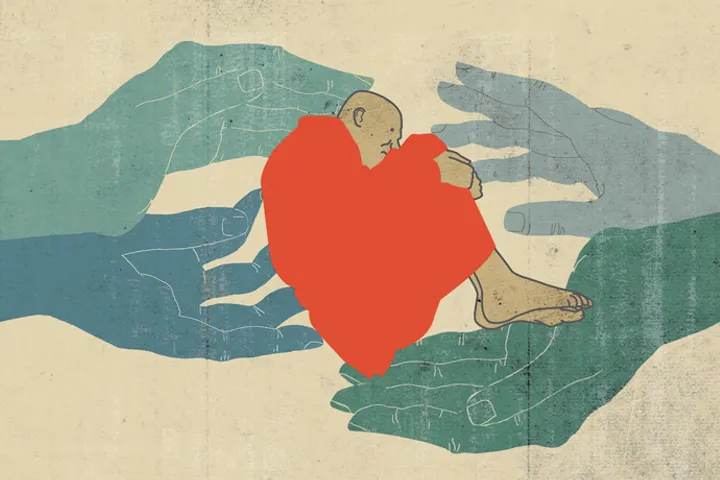If we’re reading straight through the story Scripture tells, when we arrive at the Gospels, we’ve already had quite a tour. We have experienced the birth of the cosmos, a world teeming with so much possibility and stunning beauty—and yet the whole drama turned cataclysmic almost as quickly as the show began. We reveled in the wonder of a lush and abundant garden, magnificent beyond description, only to see it spoiled by its human caretakers. What’s more, we barely nudged past the narrative’s first act before a man—out of sheer envy—murders his brother. Without needing anyone to spell the tragic truth out for us, we instinctively understand that we’re not reading any pixie-dusted fairy tale; this is going to be a gritty story indeed. And from those initial movements all the way up to the Old Testament’s final pages, none of the story’s real-world authenticity relents. For the entire time, we’ve been neck-deep in this truthful, harrowing, hopeful, desolate narrative that recounts how a world drenched with so much goodness continues to writhe in desperation for God’s rescue.

Begin Here
As we pass through the final words of the Old Testament into the New, we take a breath, and then run headlong into a set of four books: Matthew, Mark, Luke, and John—each of them insisting that they are proclaiming gospel to us. And this word gospel blazes like large neon letters at midnight, because the literal rendering of gospel is “good news.”
And just in the nick of time—after we’ve experienced disintegration of our hopes and possibilities and disillusionment over humanity’s inability to stop making a mess of things, good news is exactly what we need. Strangely, however, this new part of the story commences with (would you believe it?) a chronology, of all things. Matthew launches by ticking off, ancestor by ancestor, Jesus’ lineage: women and men who’d been buried for centuries. A real snoozer.
Except, the more we read, we discover Matthew begins with the most pedantic of human details in order to make absolutely clear something we would never have anticipated: The good news we most need is not, as many would have assumed, a religious ideal or philosophical theory or moral code but a person. In time, we’ll discover this good news is Jesus Christ, the one who in His own body brings God near to us. And more surprising still, this story doesn’t just tell us about Jesus—it invites us to encounter Him. The Gospels do not provide the dusty chronicle of an ancient religious figure but rather welcome us into a living story where, in these sacred pages, we meet the living God.
The good news we most need is not a religious ideal or philosophical theory or moral code but a person.
To be sure, the Gospels narrate a compelling biography (Jesus’ birth and ministry, His sermons, a smattering of family details, His life with the disciples, the excruciating hours around His crucifixion, and the explosive moment of His resurrection). But more than that, they encourage us to be overwhelmed, undone, and then made new by this Jesus who lives and speaks even now. In John’s gospel, we hear caution for any of us tempted to engage the words of Scripture without actually encountering the Jesus who is alive in it. “You study the Scriptures diligently,” Jesus said, “because you think that in them you have eternal life. These are the very Scriptures that testify about me, yet you refuse to come to me to have life” (John 5:39-40 NIV). We don’t read the Gospels to merely snatch more knowledge concerning Jesus. Rather, we enter the Gospels to meet and be loved and healed by Jesus. We enter the Gospels so that we might be awakened into the fullness of life.
Entering the Gospels
There are numerous books on the formation and framing of the gospels, each of them providing reams of useful information. It is immensely helpful to learn (just for starters) about the historical background and socio-political underpinning of the first-century world—the plethora of Jewish realities infusing Jesus’ life and sermons. In the same way, it’s good to learn about the unique distinctions and emphasis imbedded in each of the four gospel accounts, and the various literary forms contained within their pages. However, even with all of this vital data, it’s possible to read the words without ever actually entering the story. It’s remarkably easy to stockpile answers in our head, simply cataloging historical and theological facts without embracing (or being embraced by) the One who—in these very stories—invites us to eat with Him, walk out onto the dark and treacherous water with Him, suffer with Him, die with Him, rise from the dead with Him.

All of our best stories share this characteristic: They invite us into the action. In one of my favorite novels—Leif Enger’s Peace Like a River—Jeremiah Land stands in the delivery room where his newborn son Reuben, lungs flaccid and uncooperative, gasps and wheezes and then goes deathly still. For 12 minutes, Dr. Nokes massages Reuben’s back, pounds his chest, and works feverishly to blow air into his mouth and nose. But Reuben lies there, growing paler by the second.
Defeated, Dr. Nokes surrenders, convinced that brain damage is now certain. Jeremiah, however, refuses to give up. Against all protests, Jeremiah, in a father’s fury (such fury that when the doctor tries to stop him from grabbing his son’s limp body, the dad punches the man in the jaw and sends him sprawling across the floor), lifts up his baby. Then, with authority like that of the thundering voice from Mt. Sinai, Jeremiah tells the child, “Reuben Land, in the name of the living God, I am telling you to breathe.” And he does.
When I read Enger’s brilliant book, I was not merely struck by his sharp prose or his ability, in only a few scant sentences, to paint so vivid and desperate a picture. I wasn’t drawn to explore his literary technique or to begin postulating how the dramatic arc might unfold. Rather, I was immersed into this moment, and my eyes went red and moist as I envisioned how I would fight for one of my own sons in such a crisis of life and death, how my love would be so strong and tenacious that I’d blow past anyone standing in my way to reach him. I imagined myself holding my son’s fragile body and, with every ounce of strength I have, commanding him to breathe. After I closed those pages, I held my boys more tightly. I spoke to them with more tenderness and strength. I had entered that story, and I was changed.
I imagined myself holding my son’s fragile body and, with every ounce of strength I have, commanding him to breathe.
So it is with the Gospels. If we want to enter the world of the Scriptures with the intention of meeting Jesus and finding true life, then these books provide us the very best door. They guide us right into the center of the action. However, as we enter, we’ll need to bring our imagination with us. When instructing his readers in the art of living attentively, poet and abolitionist Henry David Thoreau liked to say the crucial question isn’t so much what we look at but what we see. This is sage advice for reading Scripture. We need more than to merely look at the words or parse the grammar or systematize all the propositions into tidy theological categories. No, we need to see Jesus. We need to have our mind and heart opened so we can encounter hope. So we can touch salvation and have an intimate rendezvous with mercy.
And if we are to truly see Jesus in the Gospels, we’ll need to move deeper, past the trite responses or easy conclusions. We’ll move into these fantastic narratives with an eye toward uncovering more than biblical data or flat-footed, simplistic moralisms. We’ll watch for nuance and subtle details. We’ll take note of how Jesus chose a wedding party as the place He wanted to come into public light. We’ll notice Jesus’ gentleness and admiration for women, something so odd in a world heavy with patriarchy. We will find it interesting how often Jesus asked questions instead of pronouncing answers. We’ll read with interest when we recognize how many times Jesus avoided crowds or refused well-intended requests or silenced His followers when you’d think He’d want them shouting from the rooftops.

Further, if we want the strange, marvelous world of the Gospels to open itself to us, we’ll need to arrive with a holy curiosity. We might, for instance, ask what it feels like to be desperate (alongside the Canaanite woman) for Jesus to heal our daughter. We may allow ourselves to tremble with terror (as the disciples surely did) when hearing Jesus insist that to truly follow Him, we’ll have to carry a cross—that horrific symbol of brutality. We might, with Peter, feel the rush of bold faith when we step into the gale, only to be consumed by fear and crashing waves mere moments later.
Our tenacious curiosity allows us to explore new or previously unnoticed angles, illuminating ways of being in conversation with the story and the text that push us from our comfort zone or press into long-ignored spaces of our heart. For instance, what would have happened if Judas had been a faithful friend instead of a betrayer? How would the story have gone differently if Pontius Pilate had demonstrated the courage to stand up to the mob? Or what exactly possessed Mary to blow a year’s wages on perfume that she’d extravagantly waste in a single profligate act: washing Jesus’ grimy feet? As pastor and writer Robert Farrar Capon was fond of saying, we “need to play with Scripture or else we’ll get it all wrong.” And without playful curiosity, we’ll get everything wrong. Because while the events in the Gospels happened long ago, the story is being relived in us even now.
When we enter the story, we recognize how familiar we are with Pilate’s cowardice or Judas’s greed.
So in the Gospels, we do not stand aloof and coolly observe the text. No, we sit with the woman caught in adultery or the royal official whose son fell ill. With them, we cling to the hope that Jesus will move toward our shame, disappointment, and pain as well. Alongside the disciples, we learn how to reckon with all the things we are unwilling to abandon for the sake of God’s kingdom. When we enter the story, we recognize how familiar we are with Pilate’s cowardice or Judas’s greed. In the Gospels, we hear Jesus calling us to lose everything and then, in the great reversal, find everything—to find true life.
It’s Not What We Think
One of the most illuminating (or disturbing) facts about the Gospels is how they scandalize most everything we think we know about God and the world. We would never expect the Savior of humanity and creation to come as a squalling baby born to some unknown family in a “backwater” place. We would never expect the King of the World to die like a common criminal on a cross of grief and humiliation. We would never expect that the One who’d eventually throw off every competing empire’s shackles would command us to love our enemies or insist that we have to die if we want to live. To proclaim that the meek, not the rich and powerful, would inherit the earth. To teach us that the poor, sad, and hungry are the ones who are truly blessed.
Spend a little time with Jesus’ parables, and you’ll find the pattern continues: The wrong people hit the jackpot (the prodigal and the publican) while the right people take a hit (the elder brother and the Pharisee). Similarly, those we assume to be exemplars (the temple officials or the diligent workers) take a back seat to ones we expect to be shady characters (the religious outsider or the tardy workers). And what was Jesus thinking when He used objects of such insignificance (a tiny mustard seed and a few tablespoons of yeast) to model for us what His kingdom is like?
What a confounding story these four books tell us.

Though critics suggested Flannery O’Connor’s characters and narratives were too grotesque or outrageous, she countered that it was sometimes necessary to shock readers into seeing truths they’ve lost or willfully ignored. “[T]o the hard of hearing you shout,” O’Connor wrote, “and for the almost-blind you draw large and startling figures.” The parables serve as Jesus’ large and startling figures: He uses them to shock our sensibilities and jolt us wide awake so that perhaps we’ll actually see the stark boldness of the life He offers.
And yet even this—Jesus using parables—is itself perplexing. Matthew tells us that Jesus used these symbolic stories every time He taught in order to befuddle those who had no interest in actually learning from Jesus or receiving what He had to offer (Matthew 13:10-13). Of course, what Jesus had to offer then is exactly what Jesus offers now: Himself. And Jesus’ startling, brain-twisting stories ask us to open our eyes and see Him for who He is, to hear His voice and answer in faith.
This is why if we enter the Gospels looking for something other than Jesus, we will be disappointed every time. While we might be tempted to come to these texts in search of some stimulating philosophy or self-help tips, the Gospels intend to offer us the One who is life. If we read merely to affirm our preconceived dogma, or insist on locating answers to the questions we believe most pressing, we shouldn’t be surprised when we leave frustrated and empty-handed. Likewise, if we enter intent on discrediting Jesus or finding additional reasons to malign faith, we ought not get too smug with whatever discrepancies we think we’ve amassed. Otherwise, we cannot honestly engage with what the Gospels actually are or aim to give us.
The Gospels’ outrageous claim is not only that Jesus upended the political expectations of first-century Judaism and sent the lives of a few dozen followers topsy-turvy, but that He will do the same for all who follow Him.
“Jesus Christ has irreparably changed the world. When preached purely, His Word exalts, frightens, shocks, and forces us to reassess our whole life.”
“Jesus Christ has irreparably changed the world,” Brennan Manning wrote. “When preached purely, His Word exalts, frightens, shocks, and forces us to reassess our whole life. The gospel breaks our train of thought, shatters our comfortable piety, and cracks open our capsule truths. The flashing spirit of Jesus Christ breaks new paths everywhere. His sentences stand like quivering swords of flame because He did not come to bring peace, but a revolution. The gospel is not a children’s fairy tale, but rather a cutting-edge, rolling-thunder, convulsive earthquake in the world of the human spirit. By entering human history, God has demolished all previous conceptions of who God is and what man is supposed to be.”
This convulsive earthquake and these quivering swords will sometimes terrify us or bewilder us, but as Jesus promises, these truths will also set us free. Matthew tells us that Jesus’ central message was unflinching: The kingdom of heaven has arrived, so we best hang on tight—everything’s changing. No matter where we go in the Gospels, we face disruption and disorientation. They are like a powder keg waiting to blow our quaint life to smithereens. Maybe when we open Mark or Luke, we should hand out hard hats and Kevlar vests and make folks sign a release of liability: I fully understand what I’m about to do is dangerous business. I am of sound mind and affirm that I have of my own free will picked up this hazardous book.
Maybe the strangest thing of all is how much good news there is in these perilous pages. Far from being ultimately destructive, the Gospels’ dynamite works to break us loose, to set us free. If the Gospels offered us only what we expected, what we believe we want or need, then we’d truly be lost. We’d be trapped by our own myopic, selfish visions.
Thankfully, the story they carry us into is so much more expansive. It’s the story of God. It’s the story of how we find our life in Him. It’s the story of how Jesus descended into the very bowels of death and came back to life. It’s the story of how everything gets made new. It’s the story of how everything evil, everything broken, everything sorrowful changes into something beautiful. It is good, good news.
Illustrations by MUTI
Click to read previous installments of the Biblical Literacy Series.





